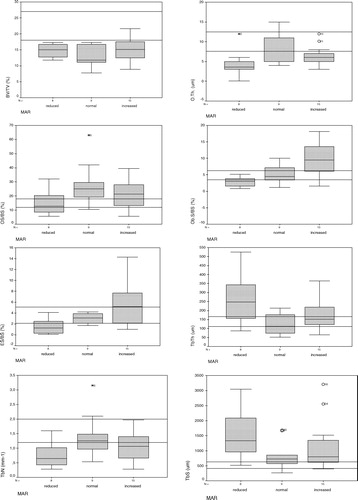Figures & data
Table I. Histomorphometric parameters measured in transiliac bone samples from 32 men with idiopathic osteoporosis.
Table II. Number of patients with idiopathic osteoporosis divided into groups with decreased, normal, or increased measured histomorphometric parameters with respect to reference values (presented in Table I).
Figure 1. Box-plot graphs for bone volume (BV/TV, %), osteoid surface (OS/BS, %), osteoid thickness (O.Th, μm), osteoblast surface (Ob.S/BS, %) eroded surface (ES/BS, %), trabecular thickness (Tb.Th, μm); trabecular number (Tb.N, mm−1); trabecular separation (Tb.S, μm); according to reduced, normal and increased mineral apposition rate (MAR, μm/day) in 32 male patients with idiopathic osteoporosis are presented as medians and quartiles, with indicated outliers (O) and extreme values (*). Horizontal lines indicate reference range (1 SD).

Table III. Comparison of patients with decreased, normal, and increased mineral apposition rate (MAR) for osteoblast surface (ObS/BS), eroded surface (ES/BS), and trabecular thickness (Tb.Th).